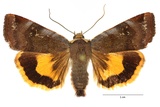Noctua janthe (Borkhausen, 1792) Species
Last modified: Oct. 2, 2025, 12:24 p.m.
A rather common species throughout Belgium, more frequent than Noctua janthina.
Data Deficient due to a lack of sufficient data according to the IUCN Red List category for Flanders 2023.
Details
- Classification
- Family: Noctuidae > Subfamily: Noctuinae > Tribus: Noctuini > Genus: Noctua > Species: Noctua janthe
- Vernacular names
- Open-breedbandhuismoeder (NL), Lesser Broad-bordered Yellow Underwing (EN), Le Collier soufré (FR), Janthe-Bandeule (DE)
- First mention in Belgium
- De Prins G. 1991. Noctua janthe (Borkhausen, 1792) en Noctua janthina (Denis & Schiffermüller, 1775), beide soorten in België (Lepidoptera: Noctuidae). — Phegea 19: 121–128. On page 121. view page
- Status
-
Native
Distribution
Imago
Wingspan 30–40 mm.
Extent of black border on upperside hindwing shows a gap near costa in contrast to Noctua janthina were it's very broad and goes completely around so that the yellow shows just as a central small patch. The underside of the forewing shows a finger-like projection of the black area into the yellow suffusion. The distal edge of the postmedian band is less acutely angled than it is on Noctua janthina. Subterminal line on upperside of forewing is 'jagged' in contrast to Noctua janthina were it's smoother and distinctly less 'jagged'. At rest present species is a little bit larger, has distinct contrastingly banded legs and is not so broad winged as Noctua janthina.
Genitalia
Little difference in the male genitalia of Noctua janthina, except in the everted vesica of the aedeagus.
Bionomics
Hibernates as a larva and pupates underground.
The adults come to light and sugar.
Flight periods
The adults fly from late June till mid-September, sometimes till well into October.
Observed on
- Host plant (species):
- Rumex obtusifolius and Prunus spinosa
- Host plant (genera):
- Lamium, Crataegus and Salix
- Substrates:
- Herbaceous plants and Shrubs
The larva lives on different species of herbaceous plants and shrubs like Lamium album, Rumex obtusifolius, Chamomilla, Crataegus, Prunus spinosa or Salix.








